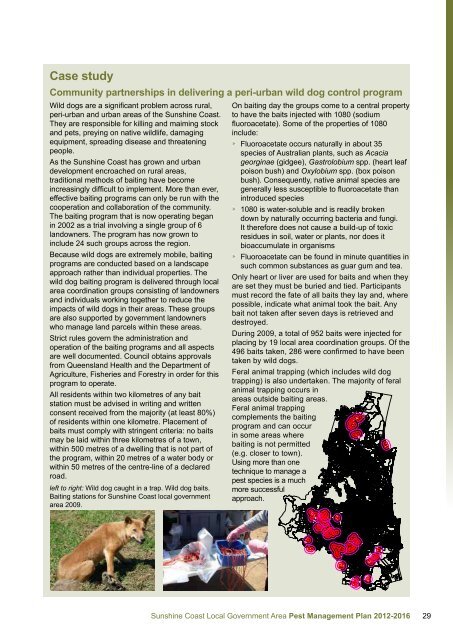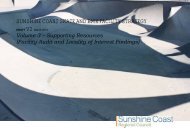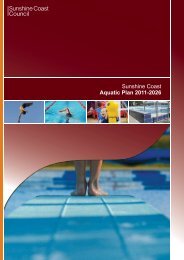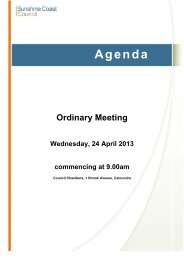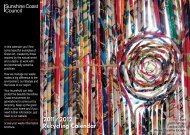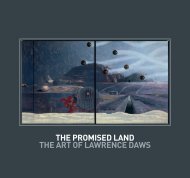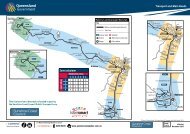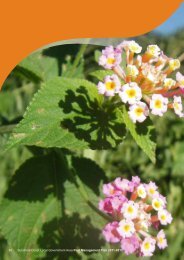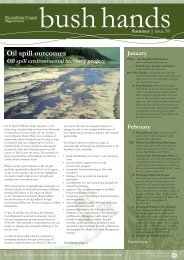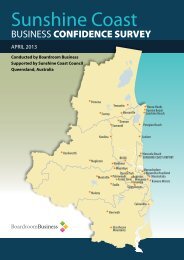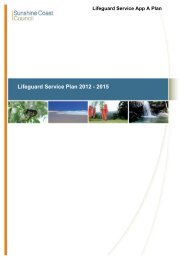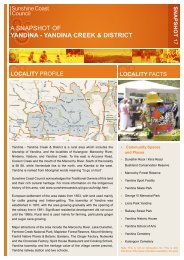Pest Management Planning - Sunshine Coast Council - Queensland ...
Pest Management Planning - Sunshine Coast Council - Queensland ...
Pest Management Planning - Sunshine Coast Council - Queensland ...
Create successful ePaper yourself
Turn your PDF publications into a flip-book with our unique Google optimized e-Paper software.
Case study<br />
Community partnerships in delivering a peri-urban wild dog control program<br />
Wild dogs are a significant problem across rural,<br />
peri-urban and urban areas of the <strong>Sunshine</strong> <strong>Coast</strong>.<br />
They are responsible for killing and maiming stock<br />
and pets, preying on native wildlife, damaging<br />
equipment, spreading disease and threatening<br />
people.<br />
As the <strong>Sunshine</strong> <strong>Coast</strong> has grown and urban<br />
development encroached on rural areas,<br />
traditional methods of baiting have become<br />
increasingly difficult to implement. More than ever,<br />
effective baiting programs can only be run with the<br />
cooperation and collaboration of the community.<br />
The baiting program that is now operating began<br />
in 2002 as a trial involving a single group of 6<br />
landowners. The program has now grown to<br />
include 24 such groups across the region.<br />
Because wild dogs are extremely mobile, baiting<br />
programs are conducted based on a landscape<br />
approach rather than individual properties. The<br />
wild dog baiting program is delivered through local<br />
area coordination groups consisting of landowners<br />
and individuals working together to reduce the<br />
impacts of wild dogs in their areas. These groups<br />
are also supported by government landowners<br />
who manage land parcels within these areas.<br />
Strict rules govern the administration and<br />
operation of the baiting programs and all aspects<br />
are well documented. <strong>Council</strong> obtains approvals<br />
from <strong>Queensland</strong> Health and the Department of<br />
Agriculture, Fisheries and Forestry in order for this<br />
program to operate.<br />
All residents within two kilometres of any bait<br />
station must be advised in writing and written<br />
consent received from the majority (at least 80%)<br />
of residents within one kilometre. Placement of<br />
baits must comply with stringent criteria: no baits<br />
may be laid within three kilometres of a town,<br />
within 500 metres of a dwelling that is not part of<br />
the program, within 20 metres of a water body or<br />
within 50 metres of the centre-line of a declared<br />
road.<br />
left to right: Wild dog caught in a trap. Wild dog baits.<br />
Baiting stations for <strong>Sunshine</strong> <strong>Coast</strong> local government<br />
area 2009.<br />
On baiting day the groups come to a central property<br />
to have the baits injected with 1080 (sodium<br />
fluoroacetate). Some of the properties of 1080<br />
include:<br />
►►<br />
Fluoroacetate occurs naturally in about 35<br />
species of Australian plants, such as Acacia<br />
georginae (gidgee), Gastrolobium spp. (heart leaf<br />
poison bush) and Oxylobium spp. (box poison<br />
bush). Consequently, native animal species are<br />
generally less susceptible to fluoroacetate than<br />
introduced species<br />
►►<br />
►►<br />
1080 is water-soluble and is readily broken<br />
down by naturally occurring bacteria and fungi.<br />
It therefore does not cause a build-up of toxic<br />
residues in soil, water or plants, nor does it<br />
bioaccumulate in organisms<br />
Fluoroacetate can be found in minute quantities in<br />
such common substances as guar gum and tea.<br />
Only heart or liver are used for baits and when they<br />
are set they must be buried and tied. Participants<br />
must record the fate of all baits they lay and, where<br />
possible, indicate what animal took the bait. Any<br />
bait not taken after seven days is retrieved and<br />
destroyed.<br />
During 2009, a total of 952 baits were injected for<br />
placing by 19 local area coordination groups. Of the<br />
496 baits taken, 286 were confirmed to have been<br />
taken by wild dogs.<br />
Feral animal trapping (which includes wild dog<br />
trapping) is also undertaken. The majority of feral<br />
animal trapping occurs in<br />
areas outside baiting areas.<br />
Feral animal trapping<br />
complements the baiting<br />
! !<br />
!<br />
!<br />
!! program and can occur<br />
! ! !! !<br />
in some areas where<br />
!<br />
!<br />
baiting is not permitted<br />
!<br />
(e.g. closer to town).<br />
Using more than one<br />
technique to manage a<br />
pest species is a much<br />
more successful<br />
approach.<br />
!<br />
! !<br />
! !<br />
!!<br />
!<br />
! !! !! !<br />
!! !<br />
!<br />
!!<br />
! !!<br />
! !<br />
!! !!!<br />
!! !<br />
!! ! !<br />
!<br />
! !! !<br />
! ! !<br />
!<br />
!<br />
!! !!<br />
!<br />
!<br />
!!<br />
!!<br />
!! !!<br />
!! !<br />
!<br />
! !!<br />
! !<br />
!<br />
!<br />
!<br />
!<br />
<strong>Sunshine</strong> <strong>Coast</strong> Local Government Area <strong>Pest</strong> <strong>Management</strong> Plan 2012-2016 29


